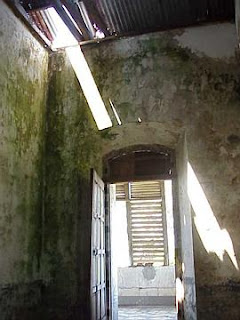(An article that won me second best travel writer slot in Philippine Star’s travel writing contest in 2004.)
 The middle-aged man with no teeth did not know where the lighthouse was. The mid-morning mahjongg players did not know where the lighthouse was. In a town where the ubiquitous welcome arch was replaced by a pair of lighthouse replicas, the townspeople lived, toiled and played mahjongg not knowing that their town housed not one, but two of those romantic antique sentinels. The few who knew did not know how, nor how long it took, to get there. Their guesstimates, two hours to half a day, were not helpful. Directions were vague and conflicting. The descriptions of extremely rough dirt roads were not very encouraging. For the less than determined, it was almost enough to give up.
The middle-aged man with no teeth did not know where the lighthouse was. The mid-morning mahjongg players did not know where the lighthouse was. In a town where the ubiquitous welcome arch was replaced by a pair of lighthouse replicas, the townspeople lived, toiled and played mahjongg not knowing that their town housed not one, but two of those romantic antique sentinels. The few who knew did not know how, nor how long it took, to get there. Their guesstimates, two hours to half a day, were not helpful. Directions were vague and conflicting. The descriptions of extremely rough dirt roads were not very encouraging. For the less than determined, it was almost enough to give up.
We were on our second day of our lighthouse hunt. The long-term goal was to visit the more than 50 Spanish-time lighthouses in the country. For this two-day jaunt, we were going to visit two – Faro de Isla de Gran Capon at Capones Island of Zambales and Faro de Punta Patar, which overlooks Cape Bolinao in Pangasinan. If we were to be technical about it, the one in Bolinao shouldn’t count because it was actually built during the American time. But we did not know that before we set off for our trip, did we? 
Our party of three got to San Antonio, Zambales midmorning. We parked our van by the seashore and arranged for a boat to bring us to the island. The boatman took us on a futile search for the lighthouse keeper who could have been at three possible places – his house, the Coast Guard station or the lighthouse itself. We did not find him in the first two places so we took the boat straight towards Capones Island.
We were first dropped off by a short stretch of a pebbly white sand beach where an imposing craggy wall of rock made a perfect photo-op background. We subdued our urge to loll and wade. We had a lighthouse keeper to find. We walked along the beach, my gym-wary, cramp-prone legs straining from walking on uneven sand and complaining with every step. Yes, still no lighthouse keeper sighting.
The boatman called us to board the boat again so we could go around the island and be dropped off where it was easier to reach the lighthouse.
Easy is a word I should use cautiously to describe the experience of getting from the boat onto the island. Because of huge rocks guarding the island, the boat could not come close to shore. What was I thinking that morning? Lighthouse equals seawater, sand, and feet getting wet. Why was I then wearing leather sandals instead of my trusted Teva’s? With no time to dwell on the inappropriateness of my footwear, I jumped into the water. It seemed a manageable knee-high level. It was knee-high all right, yet I still managed to get wet from head to foot. With the waves crashing against the rocks and my sorry non-athletic form, it was extremely challenging keeping my balance. Even after taking off my silly shoes to rely on my feet’s natural gripping abilities, I still slipped a number of times. How terrified I was of breaking my nails…er, bones. It was a shameless sight as I practically crawled on all fours to reach the beach.
 The fearsome crawl was forgotten as we got onto dry land and saw an amazing sight. We struck pay dirt and found tsinelas heaven. If you happen to be missing a rubber slipper, it is almost certain it has found its way to Capones Island where flip-flops, which have outlived their utility, come home to retire.
The fearsome crawl was forgotten as we got onto dry land and saw an amazing sight. We struck pay dirt and found tsinelas heaven. If you happen to be missing a rubber slipper, it is almost certain it has found its way to Capones Island where flip-flops, which have outlived their utility, come home to retire.
To get to the top of the island, we climbed some concrete steps. Yes, the climb was exhausting. Yes, it was steep. But the real challenge was how to avoid those cute little landmines on the way up. Welcome to the Capones goat dung festival, where goats outnumber the people and where every step is an adventure.
Some part of the steps had eroded so we had to walk through rocks. Being the health buff that I am (insert sarcastic sneer here) I breezed, or rather wheezed, through the steep climb and was out of breath when we reached the top. Then I had to catch my breath again to gasp at the view. The panoramic view of the ocean was awesome. The word magnificent was invented for moments and places like this.
We climbed a little further to get to the lighthouse. This lighthouse was inaugurated in 1890 and it obviously did not age gracefully. The lighthouse itself seemed well-preserved and boasted a fresh coat of white paint. Two bright red stripes around its girth lent it a smart, dignified look. From what we’ve heard it was maintained by the Coast Guard to keep it functioning as a sea vessel guide. The maintenance, however, was not extended to the other structures surrounding the lighthouse. Everything was in a sad state of disrepair. Ravaged by the elements, the house looked like the next typhoon could level it onto the ground. We had to use our imagination to visualize how it looked back during its glory days. Our imagination also made us start daydreaming of the many ways we can restore this lighthouse.

It would be nice to convert it into a museum. Or a café. Or a bed and breakfast. Or my own private hideaway. We conjured up visions of restoration, of sprucing it up with antique furniture, living there with books and goats as company, friends coming to visit, and serving them herbal tea which we cultivated right at the foot of the lighthouse. We dreamed, and we sighed, and we took all the snapshots our film and memory sticks could store.
We could not stay longer than half an hour. We had to go back to the boat before the tide got higher. The boat brought us back to the van. We had lunch at a nearby resort, continuing to dream out loud of lighthouse cafés and hideaways. Then, we were off to Pangasinan for lighthouse number two.
The drive to Pangasinan took the rest of the day. It was nightfall by the time we checked in at a resort in Alaminos. After breakfast the next day, we set off for Barangay Pitar in the town of Bolinao where we met the clueless, toothless man and the navigation-challenged mahjongg players.
We eventually found a man who was more knowledgeable about the lighthouses. It happened that one of the lighthouses was within finger-pointing distance. It looked old and charming from where we stood, but it was too inland to be the one we were looking for. The other lighthouse, which overlooked Cape Bolinao, was a drive away. As we had been warned, there were patches of rough bumpy roads. Undeterred, we drove on and we eventually found the place in less than an hour. The road leading to the lighthouse was lined with beach resorts. We made mental notes of good lodging options for the next time we go on another lighthouse adventure. Just as we were wondering if we were on the right path, we finally caught site of the Faro de Punta Patar. A wall, a gate and a thick patch of trees surrounded it. We knocked on the gate and screamed “Tao po” but no one came to let us in. We pushed open the unlocked gate and were welcomed by the sight of the stately lighthouse, said to be the second tallest in the country, the tallest being Cape Bojeador in Burgos, Ilocos Norte.
We walked around the property, struck by the eerie loneliness of the abandoned structures, awed by the breathtaking view of the ocean, compelled to capture everything in photos. Best we document them for who knew if these structures would stay around forever.
Like the one in Capones Island, this lighthouse was well preserved. The surrounding buildings, however, were even more decrepit than those in Capones mainly because of the materials used. The older lighthouse in Zambales was partially made of rock while the Bolinao lighthouse was almost entirely made of wood so even if the latter was a more recent structure, it had been more badly damaged by time and the elements.
 Trees were growing not just outside the house but inside as well since parts of the flooring have decayed to a point where one can no longer walk on them allowing vegetation to creep into the structure. Graffiti adorned the walls. Capiz windowpanes no longer served the purpose of covering the windows. Again, we had to use our imagination to visualize how beautiful these structures must have looked back in 1905 when they were just completed.
Trees were growing not just outside the house but inside as well since parts of the flooring have decayed to a point where one can no longer walk on them allowing vegetation to creep into the structure. Graffiti adorned the walls. Capiz windowpanes no longer served the purpose of covering the windows. Again, we had to use our imagination to visualize how beautiful these structures must have looked back in 1905 when they were just completed.
It is difficult to imagine how much work, and how much funding it would take to rehabilitate these relics of the past to their original glory. The realists in us realize that in the grand scheme of economics and national development, there are other more pressing priorities than quixotic plans of lighthouse restorations. But when we think of the possibilities, of the tourism potentials, of the sad alternative of someday losing these structures of amazing beauty, we cannot help but dream of lighthouse museums, of gift shops and seaside cafés, of romantic hideaways and lighthouse-hopping cruises. And of our next lighthouse adventure.




















